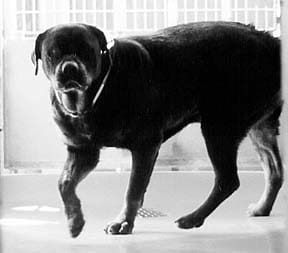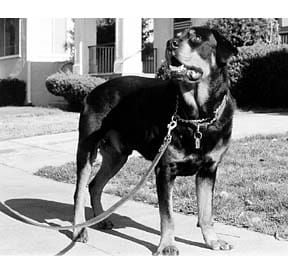Not all dogs have the benefit of a nice start in life. Sergeant had about the worst start possible. His first owners left Sergeant locked in their apartment when they abandoned it in October 1997. By the time the landlord found him, the three-year-old male Rottweiler-mix was emaciated. The landlord brought him to the Society for the Prevention of Cruelty (SPCA) of Upstate NY, a no-kill shelter. It was several days before Sergeant could eat solid food without vomiting.
He was in good hands, but Sergeant wasn’t completely safe. The unneutered male was wildly aggressive toward other dogs, and the problem was so pronounced that most shelters would have considered him unadoptable. As soon as he regained strength and energy, Sergeant began spending his days growling, snarling, and barking at the dogs in the nearby kennels.
Mark Hoag, the shelter manager, says Sergeant’s aggression was the worst he’d ever seen. Oddly enough, however, despite his cruel abandonment, the dog still regarded humans as his friends, and was warm and affectionate with shelter staffers – as long as no other dogs were nearby.

Aggressive to other dogs
Sergeant displayed an uncommon territoriality; even when he was alone in a run or in a cage, he fixated on any other dog in his sight, challenging them to fight. When in an outside run, Sergeant would wait until another dog jumped up, then grab its toes, pull its foot through the chain-link fence, and bite it.
Sergeant was soon turned out only in a run on the end of a row, with the run next to him kept empty. He spent his nights in an indoor cage in a far corner of the shelter to minimize the number of dogs he could see. When he was brought in at night he would snarl and snap at other dogs all the way down the kennel aisles.
The shelter staff had him neutered, but saw no discernible reduction in his aggression. Some volunteer dog trainers worked with him a few times. And the staff gave him toys to help him modify and displace his aggression. These approaches helped a little; Sergeant focused a little less on the other dogs. But the staffers still had to keep the run next to him empty. By February, 1998, Sergeant had been at the shelter for more than four months. If the shelter was anything but a strict “no-kill” facility, he would have been put to sleep months prior.
Flower essence blend
Then a minor miracle occurred. Celeste Caruso, of Equilite Inc., a manufacturer of flower essences for horses, contacted Hoag about having his shelter field-test her new “Pet Essences,” flower essence blends specifically formulated to address the emotional problems of small animals. Hoag thought immediately of Sergeant and some of the other dogs with behavioral problems and agreed to give the remedies a try.
Sergeant was one of the dogs selected to receive a daily dose of one of the essences. The mixture was selected by Caruso on the basis of the description of each dog’s behavior problems. Initially, the staffers knew only that the mixture that Sergeant would receive was selected for dogs with aggression problems.
At first, staffers dosed Sergeant by putting the flower essence blend directly into his mouth. The dose was two or three drops, twice a day. Sergeant was initially good about this technique, but everyone was happier when they changed to putting the drops into his water bowl.
Within three weeks, with daily administrations of the essence, Sergeant was noticeably calmer. By about the fourth week he was aggressive only toward newly arrived dogs. By the sixth week, according to shelter manager Hoag, he “turned into a big ham.” Sergeant not only played with his toys instead of taking out his aggression on them, but he also invited the other dogs to play with him. The shelter now felt it was safe to resume using the cages next to Sergeant. He did not bite or growl at the other dogs, unless it was a normal response to one of them taking his toy.
“I saw a recognizable difference in this dog,” Hoag describes. “One day he broke his lead, but when he got near another dog he just wanted to play.” It was time to discover what was in the flower essences given to Sergeant. The staff was amused to learn that the remedy given to Sergeant was called “Devil Be Gone.”
Special placement
By May, Sergeant had improved to the point where he had, at last, several serious adoption candidates. Hoag knew one of the candidates personally, a man who lived alone, with no other pets or children. It seemed like the right home for Sergeant, who would thrive in such a close (and, for him, a low-stress) household.
It was a highly successful adoption. Sergeant’s owner had no qualms about building a comfortable environment for the affectionate Rottweiler. Today, Sergeant exercises in a huge custom-built run, sleeps in the house with his person, and accompanies the man when he works alone in a building next door to his home. Clients are asked to knock before entering, so that Sergeant can be let outside before the people enter.
Sergeant no longer receives the flower essence blend, since he is living in an environment with few of the stresses that set him off in the shelter. But the mixture was a key ingredient in improving his temperament and behavior so that he was able to attract a nice owner. His life started out a bit rough, but if his luck holds, there will be a nice, uneventful end to his story.
Epilogue
The SPCA of Upstate NY is raising funds for their new shelter by selling hand-made and hand-painted “Shelter Sweeties” for $15. These are six-inch beanbag toy models of different animals from the shelter. Each toy comes with a copy of the animal’s story, and is packaged in a cardboard pooper-scooper. The first toys include the shelter’s mascots, and soon they will produce the model of and story of Sergeant.
To purchase “Shelter Sweeties,” contact the SPCA of Upstate New York at PO Box 171, Hudson Falls, NY 12839; ph (518) 798-3500.





